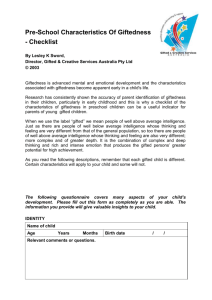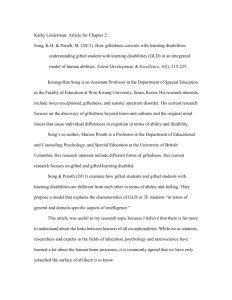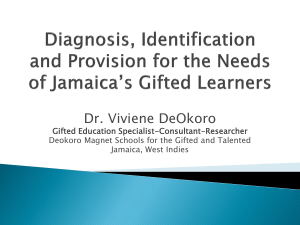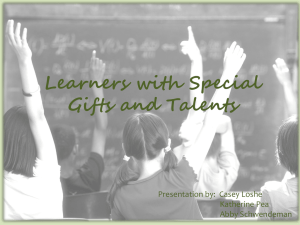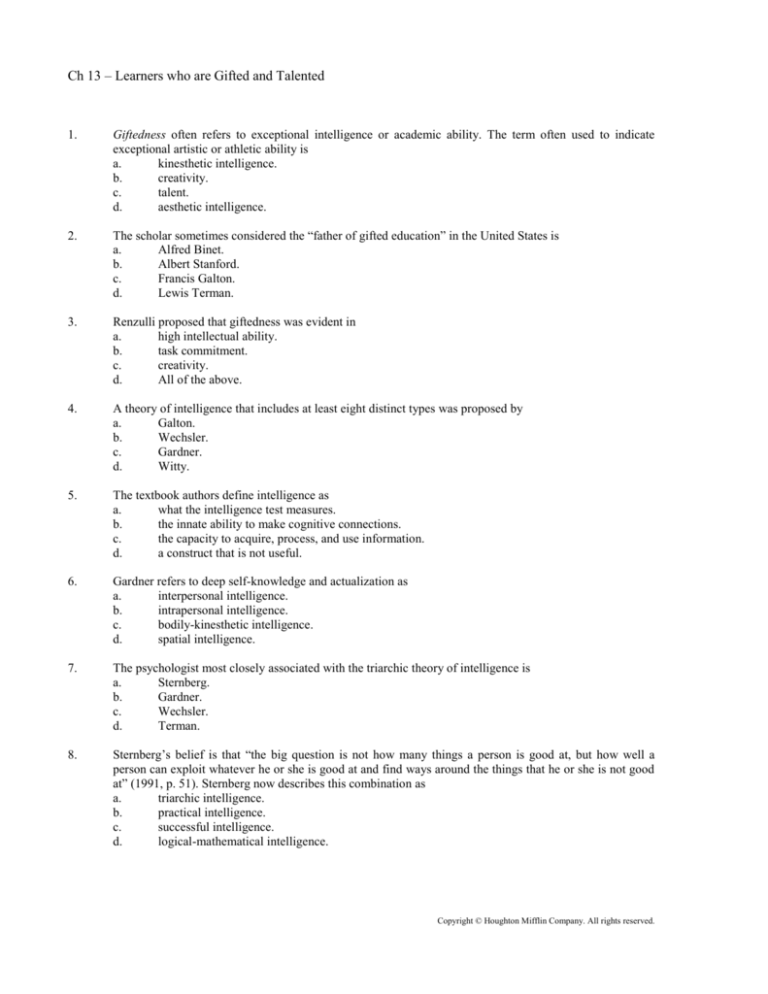
Ch 13 – Learners who are Gifted and Talented
1.
Giftedness often refers to exceptional intelligence or academic ability. The term often used to indicate
exceptional artistic or athletic ability is
a.
kinesthetic intelligence.
b.
creativity.
c.
talent.
d.
aesthetic intelligence.
2.
The scholar sometimes considered the “father of gifted education” in the United States is
a.
Alfred Binet.
b.
Albert Stanford.
c.
Francis Galton.
d.
Lewis Terman.
3.
Renzulli proposed that giftedness was evident in
a.
high intellectual ability.
b.
task commitment.
c.
creativity.
d.
All of the above.
4.
A theory of intelligence that includes at least eight distinct types was proposed by
a.
Galton.
b.
Wechsler.
c.
Gardner.
d.
Witty.
5.
The textbook authors define intelligence as
a.
what the intelligence test measures.
b.
the innate ability to make cognitive connections.
c.
the capacity to acquire, process, and use information.
d.
a construct that is not useful.
6.
Gardner refers to deep self-knowledge and actualization as
a.
interpersonal intelligence.
b.
intrapersonal intelligence.
c.
bodily-kinesthetic intelligence.
d.
spatial intelligence.
7.
The psychologist most closely associated with the triarchic theory of intelligence is
a.
Sternberg.
b.
Gardner.
c.
Wechsler.
d.
Terman.
8.
Sternberg’s belief is that “the big question is not how many things a person is good at, but how well a
person can exploit whatever he or she is good at and find ways around the things that he or she is not good
at” (1991, p. 51). Sternberg now describes this combination as
a.
triarchic intelligence.
b.
practical intelligence.
c.
successful intelligence.
d.
logical-mathematical intelligence.
Copyright © Houghton Mifflin Company. All rights reserved.
9.
Sternberg believes that developing wisdom in our students is important because
a.
students have difficulty seeing another person’s point of view.
b.
he has developed an assessment to measure wisdom.
c.
students are specifically taught to focus upon the common good.
d.
the development of wisdom can be accelerated.
10.
The federal definition of giftedness set forth in P.L. 97–35 includes all of the following areas EXCEPT
a.
sports-related performance.
b.
creativity.
c.
leadership capacity.
d.
academic competence.
11.
Among the unique features of the definition of giftedness set forth in P.L. 97–35 is
a.
inclusion of an IQ cutoff score.
b.
mention of a need for special programs.
c.
a requirement that academic performance be above average.
d.
provision of funds for gifted education.
12.
One of the most commonly used criteria for giftedness is
a.
overall physical size.
b.
exceptional auditory skills.
c.
advanced development.
d.
creativity.
13.
a.
b.
c.
d.
Which statement about the IQ tests used to identify students as gifted is correct?
They must be given individually.
They are generally considered the best measurements of giftedness.
They lead to underrepresentation of students with disabilities.
They lead to overrepresentation of linguistically diverse students.
14.
Achievement and IQ tests have been criticized as being too narrow in focus to use in the identification of
giftedness because
a.
they concentrate on divergent thinking.
b.
they focus on the traditional areas of analytic abilities and linguistic and logico-mathematical
reasoning.
c.
they are time-consuming and expensive to administer.
d.
All of the above.
15.
Researchers have found that the highest achievers in ballet, violin, piano, chess, bridge, and athletics were
those who
a.
rehearsed their skill with others.
b.
engaged in the most deliberate practice.
c.
found the most gifted teachers.
d.
had so much innate ability that their work appeared effortless.
16.
Which of the following statements about the nature-nurture debate is widely accepted?
a.
People who are gifted have superior genes.
b.
Environment accounts for the major portion of a person’s giftedness.
c.
Virtually all research supports the importance of nurturance.
d.
Environmental and hereditary variables have been shown to have equal effects.
Copyright © Houghton Mifflin Company. All rights reserved.
17. Sternberg (2003) reminds us that an individual’s intelligence must be viewed in the context of the
________________ he or she has had.
a.
family
b.
lessons
c.
opportunities
d.
genetic inheritance
18.
The personal characteristics of some highly gifted students include
a.
parents who push them to achieve.
b.
an intense drive.
c.
external motivation.
d.
self-sufficiency.
19.
The “secret weapon” that Reis and colleagues (1997) described in their study of successful college students
who were identified as both gifted and disabled was
a.
identification early in their school careers.
b.
not being required to have a roommate, thus easing the adjustment to college.
c.
remedial courses taken the summer before college to prepare those students for rigorous work.
d.
a supportive mother who had devoted herself to helping her child succeed.
20.
a.
b.
c.
d.
The term that is typically used to describe students who are gifted but whose performance in
school is low is
gifted disabled.
gifted underachiever.
gifted learning handicapped.
gifted handicapped.
21.
Which of the following methods for working with gifted underachieving students tends to be least
effective?
a.
Making curricular changes that focus on the student’s strengths and interests
b.
Involving the family through communication and encouragement
c.
Promoting the self-concept of the gifted student
d.
Developing behavior contracts and appropriate punishments
22.
Most theorists and researchers agree that approximately what percentage of the population should be
identified as gifted?
a.
1 percent
b.
5 percent
c.
10 percent
d.
20 percent
23.
The misuse and nonuse that Cohen (1990) described as the cause of underrepresentation of culturally
diverse students in programs for the gifted referred in part to
a.
using tests that had been normed on very small samples.
b.
weighting portfolio assessment too heavily in the identification of gifted students.
c.
neglecting non-test-based indicators of giftedness.
d.
administering to large groups IQ tests designed for individual assessment.
24.
The accepted term that is used to identify individuals whose IQ is in the mid-160s on an IQ test is
a.
radically gifted.
b.
extremely gifted.
c.
highly gifted.
d.
talented.
Copyright © Houghton Mifflin Company. All rights reserved.
25.
The practice of allowing a student who is gifted to skip several grades to accommodate his or her giftedness
is called
a.
acceleration.
b.
early entrance tracking.
c.
enrichment.
d.
advanced placement.
26.
Researchers agree that an important part of addressing the problem of gifted underachievers is
a.
behavioral contracts.
b.
self-regulation training.
c.
curricular changes.
d.
early identification.
27.
Terman (1954) found that highly gifted individuals were
a.
more inclined toward mental illness than their peers.
b.
less sensitive to social injustice than their peers.
c.
stronger, bigger, and healthier than their peers.
d.
likely to come from deprived environments.
28.
Renzulli and Reis (2003) described two kinds of giftedness: Schoolhouse giftedness, which can be
identified through standardized tests as well as some of the techniques we have described, and
a.
at-home giftedness.
b.
original giftedness.
c.
creative-productive giftedness.
d.
nontraditional giftedness.
29.
Differentiation of instruction can involve modifications in
a.
content, by putting more depth in the curriculum.
b.
process, by using a variety of methods and materials.
c.
products, classroom environment, and teacher behavior.
d.
All of the above.
30.
Determining what individual students already know, and allowing them the chance to explore different
concepts, subjects, or topics that tap into their talents, is called
a.
content acceleration.
b.
curriculum telescoping.
c.
cooperative learning.
d.
independent study.
31.
Which teaching procedure operates under the assumption that all students are learners and teachers, and
that all have an equal responsibility to explain to others and discuss with others?
a.
Direct instruction
b.
Cooperative learning
c.
Constructivism
d.
Stage (or developmental) theory
32.
Which of the following is an essential facet of brainstorming?
a.
Ask student groups to come up with the best answer.
b.
Encourage students to volunteer any ideas that they think will work.
c.
Encourage students to carefully weigh each contribution and evaluate its quality before
continuing.
d.
Allow only identified gifted students to participate in this high-level process.
Copyright © Houghton Mifflin Company. All rights reserved.
33.
The service-delivery option for gifted students that is most often criticized is
a.
enrichment.
b.
tracking.
c.
the gifted resource room.
d.
mentorships.
Copyright © Houghton Mifflin Company. All rights reserved.


